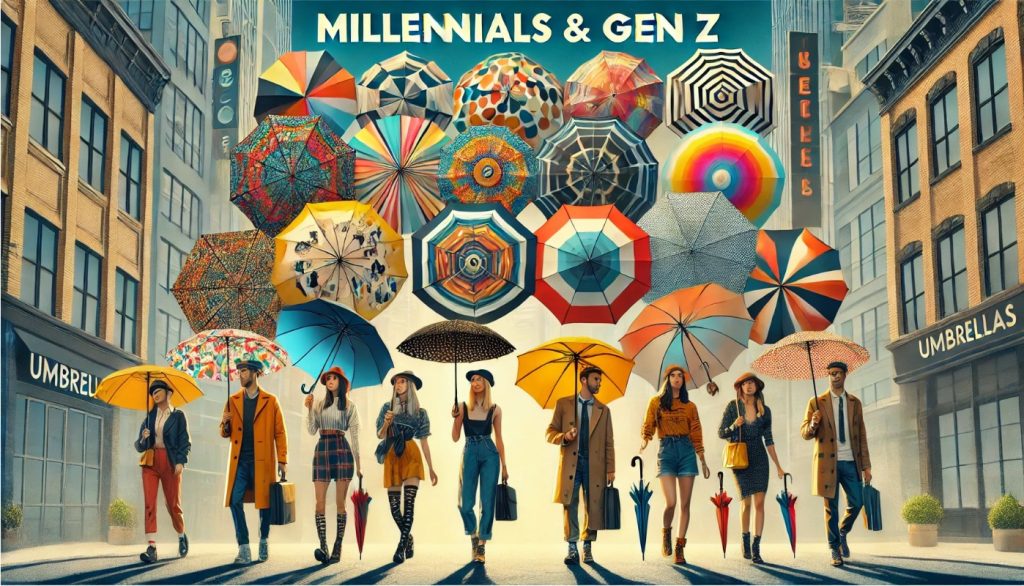The umbrella market, once largely defined by practicality, has seen significant changes in recent years as younger generations, particularly Millennials and Gen Z, have become key consumers. These two cohorts, who are often at the forefront of cultural, technological, and social trends, have influenced not only how umbrellas are designed but also how they are marketed and perceived. As fashion-forward, tech-savvy, and environmentally conscious consumers, Millennials and Gen Z are pushing the boundaries of traditional umbrella designs, bringing fresh perspectives and new demands to the industry.
The Rise of Millennial and Gen Z Consumers in the Umbrella Market
Millennials (born 1981–1996) and Gen Z (born 1997–2012) are the driving forces behind many of the trends in today’s consumer landscape. These generations, which are digitally native and highly engaged with social media, have different expectations compared to previous generations, especially when it comes to the products they buy. They are not only looking for functionality in the products they choose but also for brands that align with their values, offer personalization, and incorporate the latest technology.
Millennial and Gen Z Preferences: A Focus on Style, Function, and Experience
Millennials and Gen Z have come to expect more from everyday products, and umbrellas are no exception. While older generations may have been content with a simple, functional umbrella, younger consumers are seeking items that are both practical and stylish. This shift in consumer preferences is shaping the types of umbrellas manufacturers are creating, leading to the rise of fashionable, customizable, and feature-rich designs.
Fashion as a Key Factor in Umbrella Selection
Both Millennials and Gen Z are heavily influenced by fashion trends, and their choices often reflect their desire to stand out and express their individuality. Umbrellas are no longer just a tool for keeping dry but have become a fashion accessory in their own right. This shift has prompted umbrella brands to focus more on aesthetics, with a wide variety of designs, colors, and patterns that allow consumers to express their personality and align their umbrella choices with their wardrobe.
- Bold, Vibrant Designs: Younger consumers are gravitating toward umbrellas with bold, vibrant colors and patterns. Floral prints, graphic designs, and even limited-edition collaborations with popular artists or influencers are all increasingly seen on umbrellas. These designs are often chosen to make a statement, whether through quirky prints or eye-catching motifs that complement a personal style.
- Minimalist Appeal: At the same time, some Millennials and Gen Z consumers prefer more minimalist, understated umbrella designs. Simple color schemes, such as monochrome black, white, or gray, are favored for their versatility and ability to pair well with various outfits. This minimalist trend has influenced umbrella designers to focus on clean, sleek lines and high-quality materials that exude elegance and sophistication.
- Streetwear Influence: Many Millennials and Gen Z consumers are drawn to streetwear culture, which has increasingly influenced umbrella designs. Collaborations between umbrella brands and popular streetwear labels, featuring logos, patterns, and trendy designs, have made umbrellas a key accessory in the fashion-forward urban wardrobe.
Functionality and Technology Integration
In addition to style, both Millennials and Gen Z are drawn to products that offer enhanced functionality and smart features. These generations have grown up with technology and demand products that can integrate seamlessly into their tech-driven lives. For the umbrella market, this means incorporating features that go beyond simple rain protection and add value to the consumer experience.
- Smart Umbrellas: Tech-savvy Millennials and Gen Z consumers are pushing the demand for smart umbrellas. These umbrellas often feature built-in sensors that detect changes in the weather and automatically open or close based on real-time conditions. In addition, some smart umbrellas are equipped with Bluetooth, allowing users to track their umbrella’s location through an app, ensuring they never lose it again.
- Automatic Opening and Closing Mechanisms: With the need for convenience and efficiency, automatic umbrellas are gaining popularity. With a simple press of a button, the umbrella opens or closes with ease, making it much more convenient for users who may be juggling other items like bags or smartphones. These features are especially appealing to Millennials and Gen Z, who value time-saving and user-friendly technologies.
- Durability and Windproof Features: Both generations have shown a preference for durable, high-performance umbrellas that can withstand harsh weather conditions. Windproof designs, featuring reinforced frames and double-canopy structures that prevent the umbrella from flipping inside out, have become highly sought after. These features are particularly important for Millennials and Gen Z who live in urban environments and face unpredictable weather.
- UV Protection: As awareness about skin health and UV exposure grows, umbrellas offering UV protection are becoming increasingly popular. These umbrellas are equipped with special coatings or materials that block harmful ultraviolet rays, offering additional protection on sunny days. This feature is especially appealing to consumers who want to shield themselves from the sun while maintaining their style.
Sustainability: A Defining Value for Millennials and Gen Z
Sustainability is one of the most significant factors influencing purchasing decisions for Millennials and Gen Z. These generations are highly concerned about the environmental impact of the products they buy and are actively seeking brands that align with their values of sustainability, ethical production, and eco-conscious practices. This shift in consumer priorities is transforming the umbrella market, as manufacturers and designers are focusing on creating products that minimize environmental harm.
Eco-Friendly Materials and Manufacturing Processes
The growing demand for sustainability has led to the development of eco-friendly umbrella designs that use sustainable materials, reduce waste, and promote ethical manufacturing practices. Manufacturers are increasingly turning to recycled fabrics, biodegradable materials, and renewable resources to create umbrellas that meet the environmental values of younger consumers.
- Recycled Fabrics: Recycled polyester and nylon are now commonly used in umbrella canopies, reducing the reliance on virgin materials and helping to minimize waste. Some umbrella brands even use recycled ocean plastics or repurposed materials, aligning with Millennial and Gen Z’s desire to reduce their environmental footprint.
- Sustainable Frame Materials: The frames of umbrellas, traditionally made from plastic or metal, are now being produced with sustainable materials such as bamboo, aluminum, and recycled plastics. These eco-friendly materials not only reduce the environmental impact but also add a natural aesthetic to umbrella designs, which appeals to consumers seeking products with a lower carbon footprint.
- Ethical Production Practices: Many brands are now focused on transparency and ethical manufacturing practices. This includes ensuring fair labor practices, reducing water and energy consumption in production, and using environmentally friendly dyes and coatings. Millennials and Gen Z are willing to pay a premium for umbrellas from brands that prioritize sustainability and social responsibility.
Eco-Conscious Packaging
In addition to the umbrellas themselves, Millennials and Gen Z are also concerned about the environmental impact of packaging. As a result, umbrella brands are shifting toward minimalist, recyclable, or compostable packaging to meet these expectations. Brands that use excessive plastic packaging or non-recyclable materials are increasingly at risk of losing market share to companies that prioritize eco-conscious solutions.
- Plastic-Free Packaging: Some umbrella brands have eliminated plastic bags and packaging entirely, opting instead for cardboard or reusable fabric pouches. This not only reduces waste but also appeals to consumers who prefer products that come with minimal environmental impact.
- Sustainable Shipping Practices: Along with packaging, eco-conscious consumers are looking for brands that implement sustainable shipping methods. This may involve using carbon-neutral shipping services or consolidating shipments to reduce carbon emissions. These efforts help appeal to Millennial and Gen Z consumers who value sustainable practices across all aspects of a product’s lifecycle.
The Influence of Social Media and Digital Trends on Umbrella Preferences
Millennials and Gen Z are digital natives, spending a significant portion of their lives online and using social media platforms to influence their purchasing decisions. As such, the umbrella market has increasingly turned to social media for marketing and product inspiration. This shift has not only impacted how umbrellas are marketed but has also influenced the types of designs and trends that are popular among younger consumers.
Social Media-Driven Trends
Social media platforms like Instagram, TikTok, and Pinterest have become crucial for shaping fashion and accessory trends, including umbrellas. Influencers, celebrities, and everyday consumers alike post photos and videos showcasing their umbrella choices, often highlighting unique designs or creative ways to incorporate umbrellas into their outfits. This has contributed to the rise of trend-driven umbrella styles.
- Influencer Collaborations: Brands are increasingly collaborating with influencers to promote their umbrella designs. These collaborations can help create buzz around new collections and introduce trendy, eye-catching umbrellas to a larger audience. By tapping into influencers’ reach, umbrella brands are able to showcase their designs to a highly engaged consumer base.
- Viral Umbrella Trends: Social media challenges or viral trends often feature umbrellas in creative ways. For instance, a TikTok trend that shows off umbrellas with unique designs or functionality can rapidly drive interest and sales for certain styles. This creates an opportunity for umbrella brands to engage directly with the target audience and respond to rapidly changing trends.
- User-Generated Content: Many brands now encourage customers to post photos with their umbrellas on social media platforms using branded hashtags. This user-generated content not only builds brand loyalty but also serves as free marketing, helping to spread the brand’s message and create a community around the product.
E-Commerce and Online Shopping Preferences
The way Millennials and Gen Z shop has also influenced the umbrella market. These generations prefer online shopping, seeking a seamless, efficient, and personalized shopping experience. E-commerce platforms have become the primary channels for purchasing umbrellas, and brands are increasingly optimizing their websites and digital storefronts to cater to the preferences of these younger consumers.
- Online Customization Tools: With a desire for personalization, Millennials and Gen Z consumers are drawn to brands that offer customizable umbrellas. Online customization tools that allow customers to select colors, patterns, and even add monograms or logos have become increasingly popular. This level of personalization allows these generations to create an umbrella that reflects their unique style.
- Subscription Services and Limited-Edition Drops: In line with the rise of subscription services and exclusive product releases, some umbrella brands have started offering limited-edition collections or monthly subscription services. These models cater to the younger consumer’s desire for exclusivity and the excitement of receiving new, on-trend products regularly.
The Future of Umbrella Designs for Millennials and Gen Z
As Millennials and Gen Z continue to drive trends and shape the market, the future of umbrella design looks promising. Innovation in materials, technology, and functionality will likely continue to be at the forefront of design, with a strong emphasis on sustainability, personalization, and style.
- Smart and Sustainable Umbrellas: The next generation of umbrellas will likely integrate even more advanced technology, such as solar-powered umbrellas that can charge devices, or app-connected umbrellas that sync with weather data to alert users when it’s about to rain. At the same time, sustainability will remain a major focus, with further innovations in eco-friendly materials and ethical production practices.
- Customization and Personalization: As the desire for personalized products grows, we can expect to see more umbrella brands offering custom designs that cater to individual tastes. These could include 3D-printed frames, interchangeable canopies, or even custom branding options that appeal to Millennials and Gen Z consumers.
- Influence of Fashion and Pop Culture: As Millennials and Gen Z continue to be influenced by fashion and pop culture, we can expect to see more collaborations between umbrella brands and well-known designers, influencers, and celebrities. These collaborations will bring exclusive, on-trend designs to the market and keep the umbrella industry dynamic and relevant to younger consumers.
As these generations continue to shape the market, the umbrella industry will need to stay agile, adapting to their evolving needs and desires. The result will be a more diverse, innovative, and fashion-forward umbrella market, where style, functionality, and sustainability intersect in exciting new ways.







